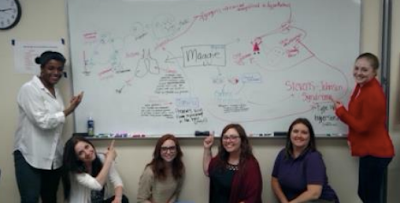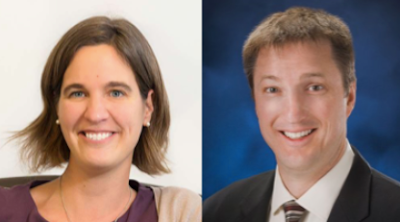From the 6/12/2020 newsletter
Marrying the Basic Sciences to Clinical Medicine
Amy J. Prunuske, PhD and Jacob Prunuske, MD, MSPH - Faculty members at UW-Central Wisconsin
We recently celebrated our twentieth wedding anniversary. Spring 2000 was a busy time. Jake graduated from medical school. We had our wedding in Milwaukee, a honeymoon in Peru, and a move to Utah where Jake began a family medicine residency and Amy started graduate school in molecular biology. The next twenty years involved both conflict and resolution as we learned to balance individual and shared goals. They also gave us plenty of opportunities to discuss the relationship between clinical medicine and the basic sciences.
We met in a laboratory studying a mouse model of familial adenomatous polyposis that, like most basic science research, attempted to understand the causal relationships that contribute to health and disease. These basic science relationships form the foundation of medicine, lending insights into how health problems manifest, generating the rationale for new treatments, and creating new diagnostic tools.
Amy’s PhD thesis in Oncological Sciences involved studying the zinc finger domain of the nuclear pore protein Nup153 for five years. She patented an inhibitor to this domain that would block cell division, but like many discoveries, it has yet to be translated into clinical practice.
At the same time, Jake was progressing through his residency realizing that patients were complex and had multiple concerns that did not come with neat labels. He needed to integrate biomedical, psychosocial, clinical, and community knowledge to make appropriate diagnoses and develop care plans that were meaningful for his patients. Classes of drugs and new immunizations continued to emerge, and Jake used his Handspring personal digital assistant to look-up dosing, side effects, or immunization recommendations.
As we progressed in our careers, we realized we needed additional training to better apply medical knowledge in a multi-faceted world. Jake completed a Master of Science in Public Health and Amy broadened her expertise into other disciplines and in systems thinking. It became clear that diseases like tuberculosis were as positively impacted by better nutrition and the minimum real wage as Koch’s discovery of the causative bacilus.
Over the years, medical school curricula have had to absorb even more new scientific and clinical discoveries. The volume of material has made it difficult for students to see connections. The time and space for students to reflect and apply knowledge to clinical practice in a productivity-based world is limited. This is all happening at a time when we and people at other institutions are pursuing accelerated graduation options aimed at expanding our primary care workforce.
Our training in education allowed us the opportunity to reflect on how current instructional environments prepare medical students for residency. Based on our own backgrounds, we focused on finding better, more meaningful ways to integrate the basic and clinical sciences.
Merging the basic and clinical sciences requires attention to content, teaching methods, learning experiences, and evaluation; it cannot be accomplished solely within a single course or clerkship. Integration must occur longitudinally and within the mind of the learner. Integration also requires inclusion; you can put both the clinician and the basic scientist in the same room, but if both don’t feel welcomed and valued, a shared model will not emerge. Learning will suffer.
To address this need, MCW created courses like “Bench to Bedside” and “Symptoms” to create environments where the basic and clinical sciences are integrated. More case studies were incorporated into basic science courses. At the same time, the USMLE Step1 exam included questions that require students to apply basic science knowledge in a clinical context.
Contextualized learning moved beyond rote memorization and these approaches fostered inclusion and true integration. Students benefited from exploring many variations of disease and illness. Likewise, students absorbed core basic science knowledge and concepts when they saw the relevance of applying those concepts in a variety of clinical situations.
Here’s an example. Students may be able to list the classic presenting features of angina and describe the presentation and findings of a pneumothorax, yet still struggle to put together a differential diagnosis for chest pain. This is not a trivial problem since, in a family doctor’s office, chest pain may be cardiac (angina, pericarditis) pulmonary (pneumothorax, pulmonary embolism, pneumonia, pleurisy), GI (dyspepsia, GERD, PUD, esophageal stricture), musculoskeletal (intercostal muscle strain, referred pain) or mental health related (anxiety, psychosomatic). “Concept mapping” helps students link patient symptoms, clinical signs, and critical biomedical sciences concepts. Effective teaching allows for students to apply knowledge obtained from multiple sources to their diagnostic reasoning ability and the health of their patients.
 |
| Students working on a concept map |
By creating maps and tying concepts together, students learn to be skeptical and to evaluate how the knowledge was acquired in the first place. They consider in what situations the knowledge does – and does not – apply. These critical analyses can be facilitated by both PhD scientists and clinicians through journal clubs and mentorship.
Novice learners rely heavily on contextual information but may lack understanding the underlying concepts. Given the time and space, students are naturally curious and connect classroom content with clinical experiences. Tools like concept maps can promote cognitive integration, helping learners understand the complex relationships between basic science knowledge, patient symptoms, clinical signs, clinical management, and decision making.
There are challenges to creating a truly integrated curriculum. Transformation requires cooperation and willingness to remove and alter course content, which can be especially difficult when people have built careers around the existing materials. Clinicians and basic scientists need to be open to collaborating and rethinking their approaches.
The payoff is worth it, though. Integrative approaches improve medical student attitudes towards the importance of the basic sciences, increase student retention of knowledge, and support success for students who are underrepresented in medicine. These experiences also model strong working relationships between basic scientists and clinicians for the students.
Similar to creating a thriving marriage, transforming education by integrating the basic and clinical sciences requires a willingness to try new approaches, an openness to considering the other person’s perspectives, and alignment of expectations. True partnership stems from a mutual respect for each other’s strengths, opportunities for both partners to achieve their goals, and room for disagreements. Only then, will we see growth.
Amy Prunuske, PhD is on the basic science faculty at MCW-Central Wisconsin.
Jacob Prunuske, MD MSPH is the Assistant Dean for Clinical Learning at MCW- Central Wisconsin.



